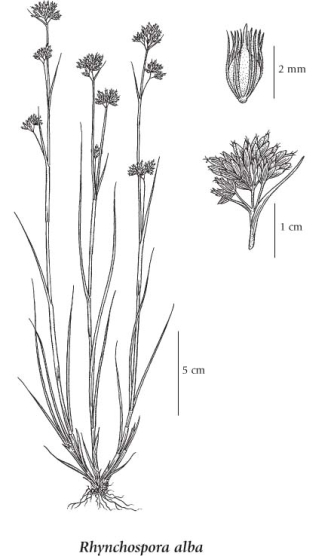Rhynchospora alba (L.) Vahl
white beak-rush (white beaksedge)
Cyperaceae (Sedge family)
Introduction to Vascular Plants
white beak-rush (white beaksedge)
Cyperaceae (Sedge family)
Introduction to Vascular Plants
Species Information
General:
Perennial, densely tufted herb from fibrous roots; stems slender, more or less solid, triangular in cross-section, usually longer than the leaves, (8) 15-50 cm tall.
Leaves:
Sheaths straw-coloured, more or less persistent, closed; blades several, on the stem, the lowest more or less reduced, often to mere scales, the others slender and elongate, folded or triangular in cross-section to thick and flat, 0.3-1 mm wide.
Flowers:
Inflorescence of 1 to 3, compact, axillary or terminal heads, mostly 5-15 mm wide, the terminal head larger than the others, each head with several to many spikes, the spikes white, becoming pale brown, often with a whitish or pinkish tinge, mostly 3.5-5 mm long, 2- to 3-flowered; involucral bracts longer or shorter than the inflorescence, 0.5-6 cm long.
Fruits:
Scales egg-shaped or lanceolate, pale brown, translucent on the margins, spirally arranged within the spikes; perianth bristles 10 to 12, well-developed, minutely finely barbed backwards, surpassing the achene bodies and sometimes also the tubercles; achenes lens-shaped, 1.5-2.5 mm long; broadest above the middle, tapering to narrow, nearly stalked bases, capped by elongate, narrow awl-like tubercles, about 1/3 to 1/2 as long as the achenes.
Illustration

If more than one illustration is available for a species (e.g., separate illustrations were provided for two subspecies) then links to the separate images will be provided below. Note that individual subspecies or varietal illustrations are not always available.
Illustration Source: The Illustrated Flora of British Columbia
Ecology
Ecological Framework for Rhynchospora alba
The table below shows the species-specific information calculated from
original data (BEC database) provided by the BC Ministry of Forests and Range.
(Updated August, 2013)
The table below shows the species-specific information calculated from
original data (BEC database) provided by the BC Ministry of Forests and Range.
(Updated August, 2013)
| Site Information |
Value / Class |
||
|
Avg |
Min |
Max |
|
| Elevation
(metres) |
278 | 10 | 1529 |
| Slope
Gradient (%) |
5 | 0 | 45 |
|
Aspect (degrees) |
357 | 2 | 360 |
| Soil
Moisture Regime (SMR) [0 - very xeric; 4 - mesic; 8 - hydric] |
6 | 1 | 8 |
| Modal
Nutrient Regime
Class |
A | ||
| #
of field plots species was recorded in: |
155 | ||
| Modal
BEC Zone Class |
CWH | ||
|
All BEC Zones (# of stations/zone) species was recorded in |
BWBS(5), CDF(9), CWH(123), ESSF(3), ICH(9), MH(2), SBS(4) | ||
|
Source:
Klinkenberg 2013
|
|||
Habitat and Range
Bogs and fens in the lowland and montane zones; frequent in and W of the Coast-Cascade Mountains in BC south of 56degreeN, rare in SC BC; circumpolar, N to SW AK, E to NF and S to ME, MA, NC, IN, IL, MN, ID and CA; West Indies, Eurasia.Status Information
Synonyms
Synonyms and Alternate Names:
Rhynchospora luquillensis Britt.